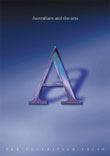Reviews: Paul Costantoura, Saatchi & Saatchi |
|
|
 |
I remember I was a little drunk when I walked home. Well, tipsy anyway. Give artists free booze and that's what's happening. Oh, I do remember that I ran into José Borghino, Executive Director of the Australian Society of Authors on the way to the event and he knew where the football stadium was (fancy this: arts meet sport) and when we got in, Nicola Evans from the Literature Fund of the Australia Council spotted me and waved me to sit next to her. So far, so good, but what the **** am I talking about? Australians and the arts? Yeah, sort of. Long before the book (beautiful and expensive) hit the shelves, this Saatchi & Saatchi report commissioned by the Australia Council was launched on CD-ROM. Very appropriately, 'Australians' and 'the artists' were invited and there were endless speeches by contributors to this survey about strategies and visions, like to enrich the life of the nation by supporting and promoting the arts. Keen readers can pop the disk into their computer and watch 'Seares.mov' (aka Dr Margaret Seares, Chair of the Australia Council) and other speeches on screen. And then came the free booze... But let us go back to the book. The result is now carved in stone (or paper) rather than burned onto CD-ROM (which is btw also glued onto the back of the hardcover). The big letter 'A' on the cover stands for Australia, as for the arts, but what is there to be researched, why is there so much money gone into talking about the arts rather than just doing it and spend money on supporting the arts, like in the Old World, where culture and arts came naturally? Paul Costantoura's varied career includes work in scientific writing, as a trade policy analyst and ministerial adviser. He has taught statistics and now works as a professional market researcher for Saatchi & Saatchi in London. Hence we can expect thoroughly prepared material on 376 thin paper pages. But why do we need it? Europeans know who they are, and their bohemian artistic expressions have been shaped from top to toe (roots). The arts have been their tradition, spanning over many centuries. In Austria, for example, we would perhaps have never commissioned such work. In Australia, the roots are not as easy to define. We are a country of many cultures. And the report does not forget about country-of-origin statistics, diversity within the population, non-English speaking origin and Aboriginal and Torres Strait Islanders. Nor about income, education, the arts and living with a household income of less than $25,000, which applies to 23% of the Australian population. However, I am not so sure that this report on the Australia Council's "Study Questionnaire" does the job. With the price tag of $75 and a dry academic style it does not appeal to people who have had none or not much exposure to arts as it fails to give them answers to questions like: What are 'the arts'? Or, how can Australians 'value' the arts? It would have been OK to make it compulsory reading for Australia Council staff and politicians (for the many meaningful recommendations to promote the value of the arts). And maybe as a text book for university students and teachers. And for me? It's interesting reading. I probably will have it on the bedside table for several weeks. But why would Tom, Dick and Harry want to know: 'What people don't like about the arts'? This is probably best answered in Comment 15 on page 64: If I don't care, I don't know. Or ask the 'arts lovers' on page 319 - the arts 'r' for us: They show us what it takes in Australia to be truly committed to the arts [...] well-educated, inner-city dwelling women in households with reasonably high incomes. Surprised? |
| Reviewed by Gerald Ganglbauer, 31 October 2001 | |